Essay: Applying a New Leadership Style and Organizational Context
VerifiedAdded on 2020/05/16
|9
|2195
|58
Essay
AI Summary
This essay proposes a new leadership model centered on compassion and discipline, contrasting it with existing theories like Contingency, Behavioral, and Transactional/Transformational leadership. The author argues that compassion, encompassing love and care, is a crucial trait for leaders, complemented by discipline. The essay outlines the traits of this new leader, including communication, motivation, and time management, alongside core values such as integrity, courage, and genuineness. It explores the application of this model in an organizational context, referencing Google as an example, and highlights the importance of ethical conduct and prioritizing human resources. The essay concludes by emphasizing the significance of good leadership for organizational success and the need to treat employees with compassion and respect. It also details how the author would personally implement this model.
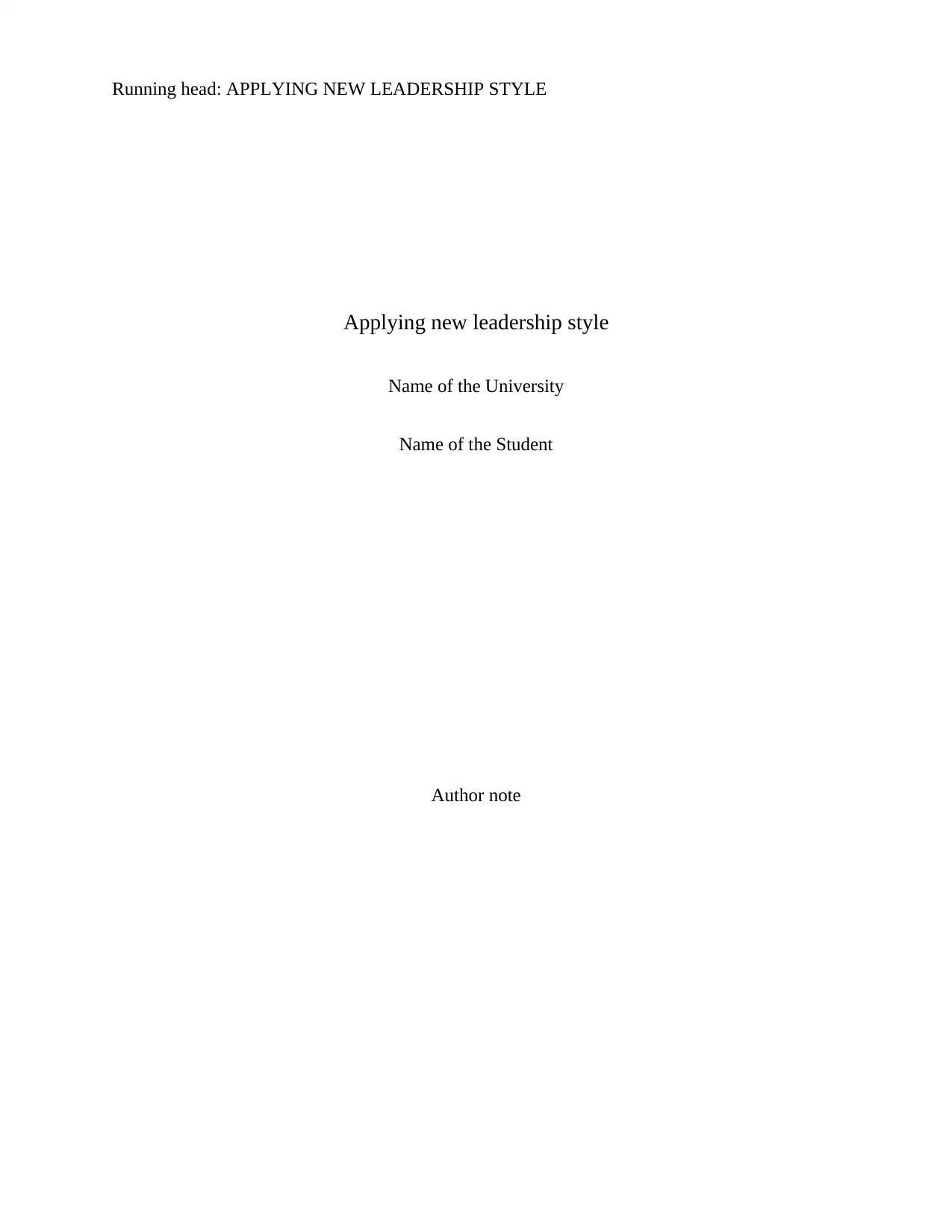
Running head: APPLYING NEW LEADERSHIP STYLE
Applying new leadership style
Name of the University
Name of the Student
Author note
Applying new leadership style
Name of the University
Name of the Student
Author note
Paraphrase This Document
Need a fresh take? Get an instant paraphrase of this document with our AI Paraphraser
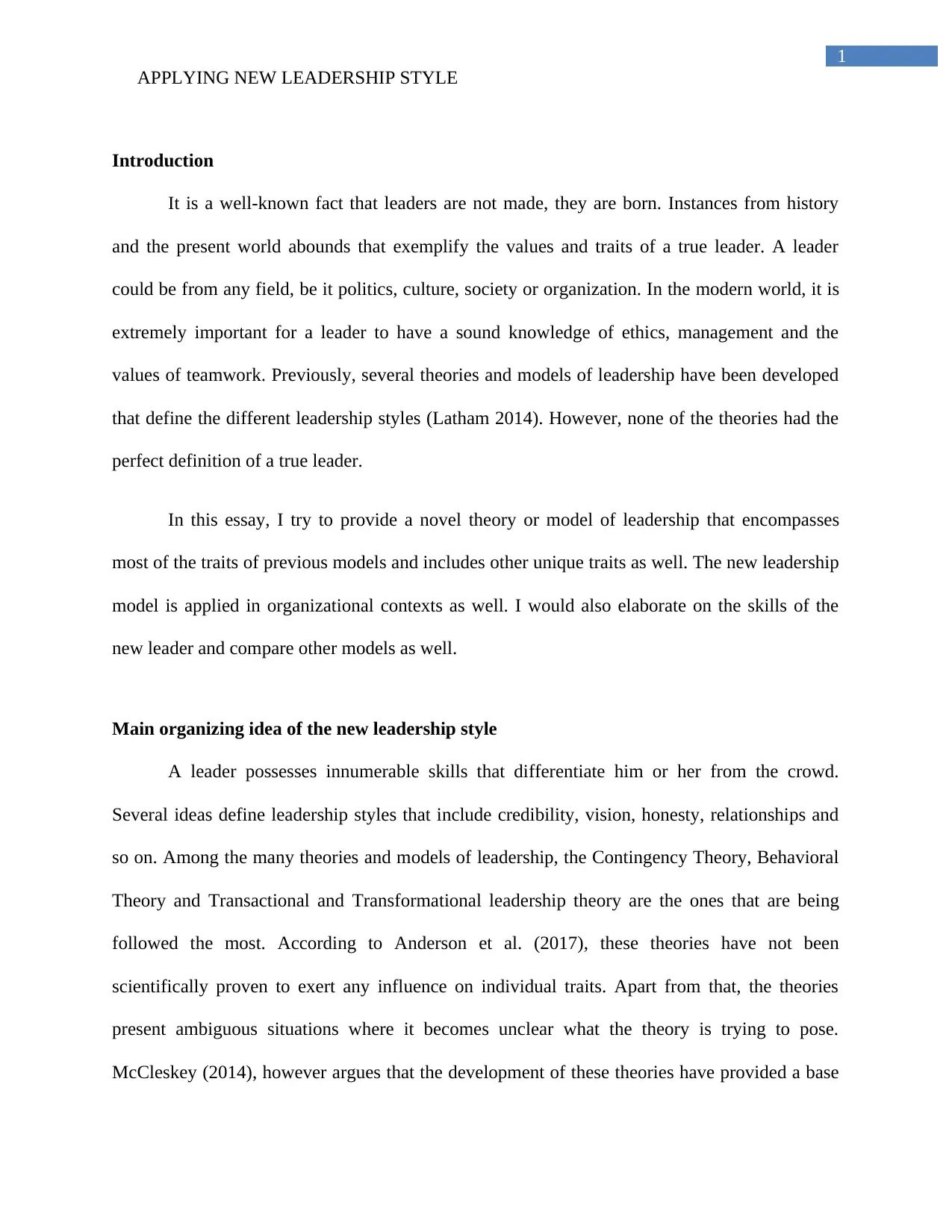
1
APPLYING NEW LEADERSHIP STYLE
Introduction
It is a well-known fact that leaders are not made, they are born. Instances from history
and the present world abounds that exemplify the values and traits of a true leader. A leader
could be from any field, be it politics, culture, society or organization. In the modern world, it is
extremely important for a leader to have a sound knowledge of ethics, management and the
values of teamwork. Previously, several theories and models of leadership have been developed
that define the different leadership styles (Latham 2014). However, none of the theories had the
perfect definition of a true leader.
In this essay, I try to provide a novel theory or model of leadership that encompasses
most of the traits of previous models and includes other unique traits as well. The new leadership
model is applied in organizational contexts as well. I would also elaborate on the skills of the
new leader and compare other models as well.
Main organizing idea of the new leadership style
A leader possesses innumerable skills that differentiate him or her from the crowd.
Several ideas define leadership styles that include credibility, vision, honesty, relationships and
so on. Among the many theories and models of leadership, the Contingency Theory, Behavioral
Theory and Transactional and Transformational leadership theory are the ones that are being
followed the most. According to Anderson et al. (2017), these theories have not been
scientifically proven to exert any influence on individual traits. Apart from that, the theories
present ambiguous situations where it becomes unclear what the theory is trying to pose.
McCleskey (2014), however argues that the development of these theories have provided a base
APPLYING NEW LEADERSHIP STYLE
Introduction
It is a well-known fact that leaders are not made, they are born. Instances from history
and the present world abounds that exemplify the values and traits of a true leader. A leader
could be from any field, be it politics, culture, society or organization. In the modern world, it is
extremely important for a leader to have a sound knowledge of ethics, management and the
values of teamwork. Previously, several theories and models of leadership have been developed
that define the different leadership styles (Latham 2014). However, none of the theories had the
perfect definition of a true leader.
In this essay, I try to provide a novel theory or model of leadership that encompasses
most of the traits of previous models and includes other unique traits as well. The new leadership
model is applied in organizational contexts as well. I would also elaborate on the skills of the
new leader and compare other models as well.
Main organizing idea of the new leadership style
A leader possesses innumerable skills that differentiate him or her from the crowd.
Several ideas define leadership styles that include credibility, vision, honesty, relationships and
so on. Among the many theories and models of leadership, the Contingency Theory, Behavioral
Theory and Transactional and Transformational leadership theory are the ones that are being
followed the most. According to Anderson et al. (2017), these theories have not been
scientifically proven to exert any influence on individual traits. Apart from that, the theories
present ambiguous situations where it becomes unclear what the theory is trying to pose.
McCleskey (2014), however argues that the development of these theories have provided a base
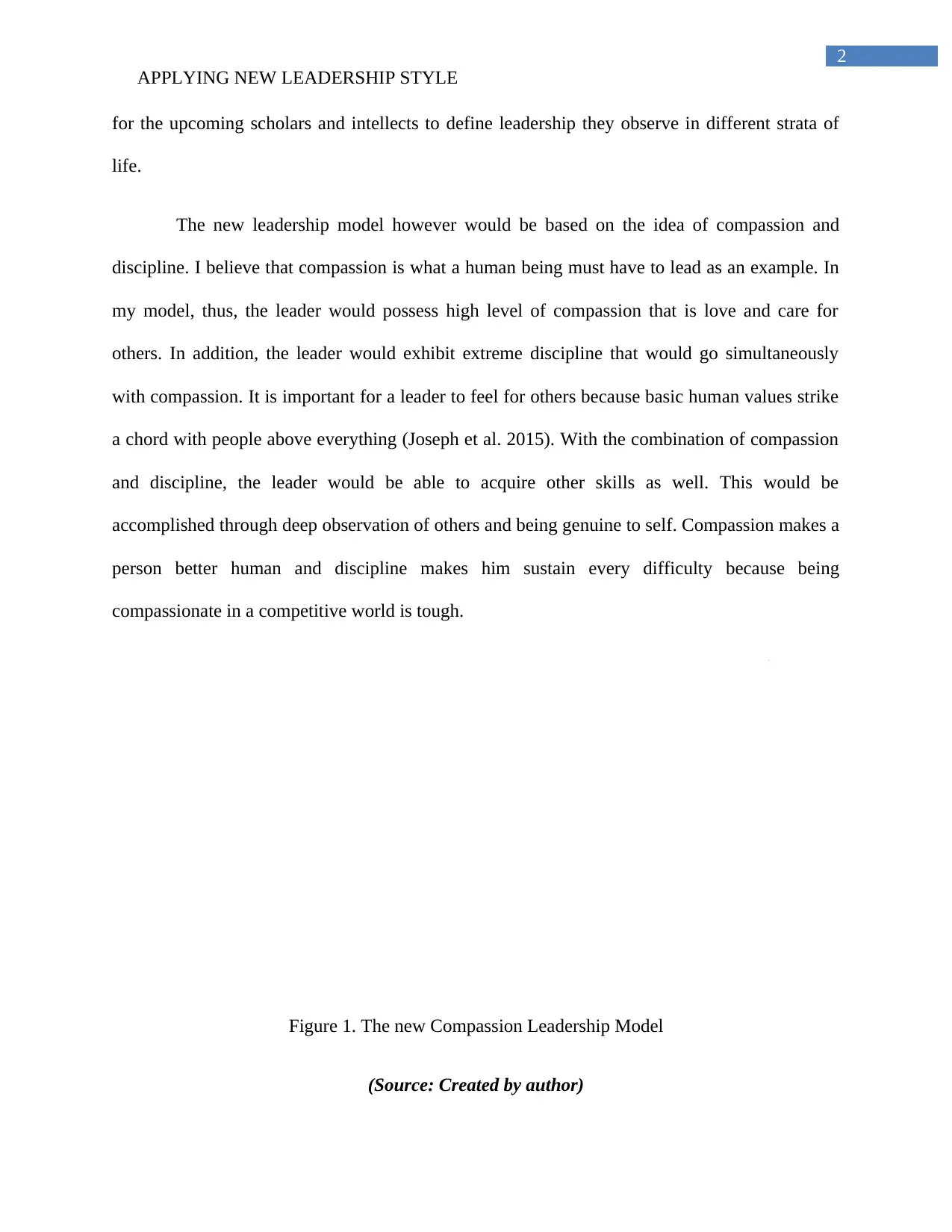
2
APPLYING NEW LEADERSHIP STYLE
for the upcoming scholars and intellects to define leadership they observe in different strata of
life.
The new leadership model however would be based on the idea of compassion and
discipline. I believe that compassion is what a human being must have to lead as an example. In
my model, thus, the leader would possess high level of compassion that is love and care for
others. In addition, the leader would exhibit extreme discipline that would go simultaneously
with compassion. It is important for a leader to feel for others because basic human values strike
a chord with people above everything (Joseph et al. 2015). With the combination of compassion
and discipline, the leader would be able to acquire other skills as well. This would be
accomplished through deep observation of others and being genuine to self. Compassion makes a
person better human and discipline makes him sustain every difficulty because being
compassionate in a competitive world is tough.
Figure 1. The new Compassion Leadership Model
(Source: Created by author)
APPLYING NEW LEADERSHIP STYLE
for the upcoming scholars and intellects to define leadership they observe in different strata of
life.
The new leadership model however would be based on the idea of compassion and
discipline. I believe that compassion is what a human being must have to lead as an example. In
my model, thus, the leader would possess high level of compassion that is love and care for
others. In addition, the leader would exhibit extreme discipline that would go simultaneously
with compassion. It is important for a leader to feel for others because basic human values strike
a chord with people above everything (Joseph et al. 2015). With the combination of compassion
and discipline, the leader would be able to acquire other skills as well. This would be
accomplished through deep observation of others and being genuine to self. Compassion makes a
person better human and discipline makes him sustain every difficulty because being
compassionate in a competitive world is tough.
Figure 1. The new Compassion Leadership Model
(Source: Created by author)
⊘ This is a preview!⊘
Do you want full access?
Subscribe today to unlock all pages.

Trusted by 1+ million students worldwide
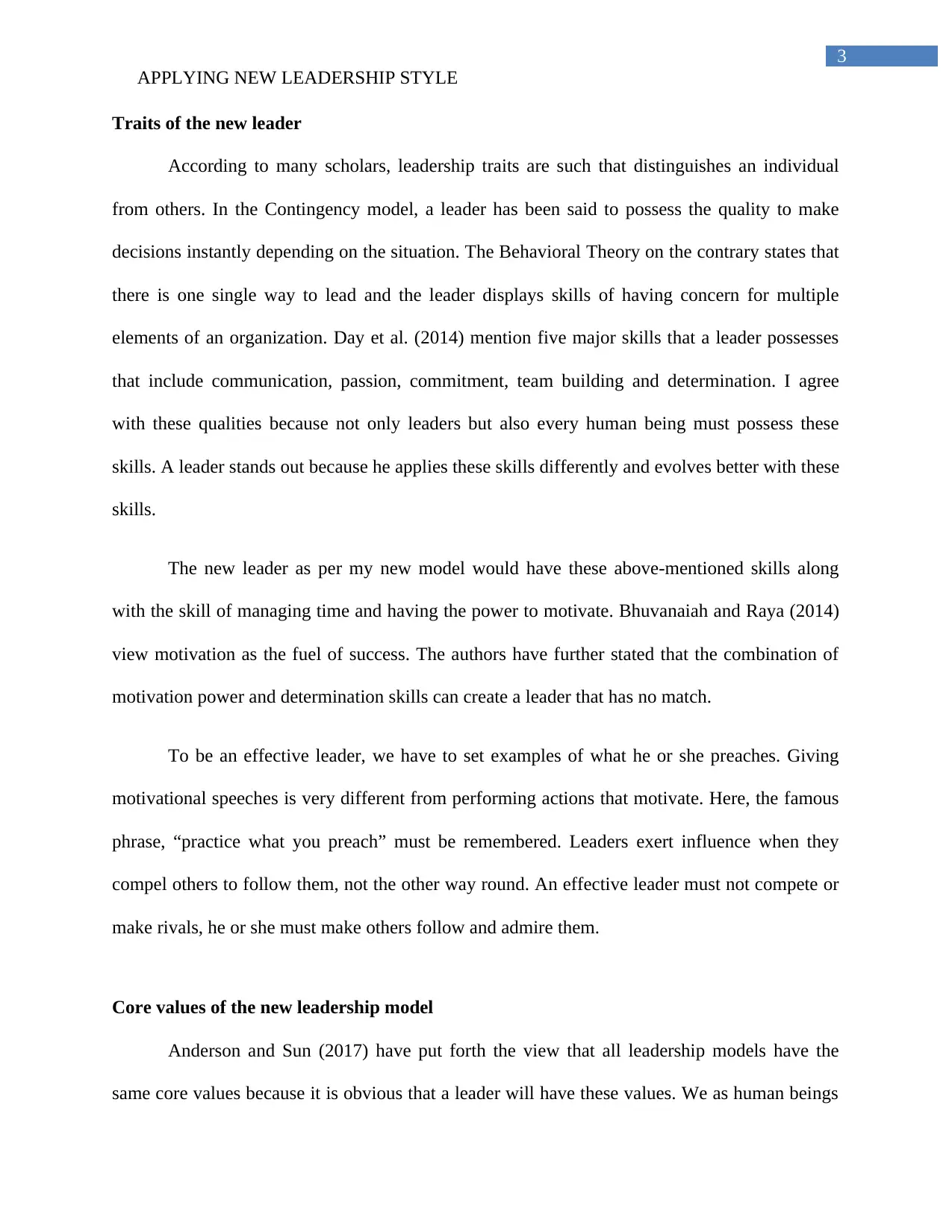
3
APPLYING NEW LEADERSHIP STYLE
Traits of the new leader
According to many scholars, leadership traits are such that distinguishes an individual
from others. In the Contingency model, a leader has been said to possess the quality to make
decisions instantly depending on the situation. The Behavioral Theory on the contrary states that
there is one single way to lead and the leader displays skills of having concern for multiple
elements of an organization. Day et al. (2014) mention five major skills that a leader possesses
that include communication, passion, commitment, team building and determination. I agree
with these qualities because not only leaders but also every human being must possess these
skills. A leader stands out because he applies these skills differently and evolves better with these
skills.
The new leader as per my new model would have these above-mentioned skills along
with the skill of managing time and having the power to motivate. Bhuvanaiah and Raya (2014)
view motivation as the fuel of success. The authors have further stated that the combination of
motivation power and determination skills can create a leader that has no match.
To be an effective leader, we have to set examples of what he or she preaches. Giving
motivational speeches is very different from performing actions that motivate. Here, the famous
phrase, “practice what you preach” must be remembered. Leaders exert influence when they
compel others to follow them, not the other way round. An effective leader must not compete or
make rivals, he or she must make others follow and admire them.
Core values of the new leadership model
Anderson and Sun (2017) have put forth the view that all leadership models have the
same core values because it is obvious that a leader will have these values. We as human beings
APPLYING NEW LEADERSHIP STYLE
Traits of the new leader
According to many scholars, leadership traits are such that distinguishes an individual
from others. In the Contingency model, a leader has been said to possess the quality to make
decisions instantly depending on the situation. The Behavioral Theory on the contrary states that
there is one single way to lead and the leader displays skills of having concern for multiple
elements of an organization. Day et al. (2014) mention five major skills that a leader possesses
that include communication, passion, commitment, team building and determination. I agree
with these qualities because not only leaders but also every human being must possess these
skills. A leader stands out because he applies these skills differently and evolves better with these
skills.
The new leader as per my new model would have these above-mentioned skills along
with the skill of managing time and having the power to motivate. Bhuvanaiah and Raya (2014)
view motivation as the fuel of success. The authors have further stated that the combination of
motivation power and determination skills can create a leader that has no match.
To be an effective leader, we have to set examples of what he or she preaches. Giving
motivational speeches is very different from performing actions that motivate. Here, the famous
phrase, “practice what you preach” must be remembered. Leaders exert influence when they
compel others to follow them, not the other way round. An effective leader must not compete or
make rivals, he or she must make others follow and admire them.
Core values of the new leadership model
Anderson and Sun (2017) have put forth the view that all leadership models have the
same core values because it is obvious that a leader will have these values. We as human beings
Paraphrase This Document
Need a fresh take? Get an instant paraphrase of this document with our AI Paraphraser
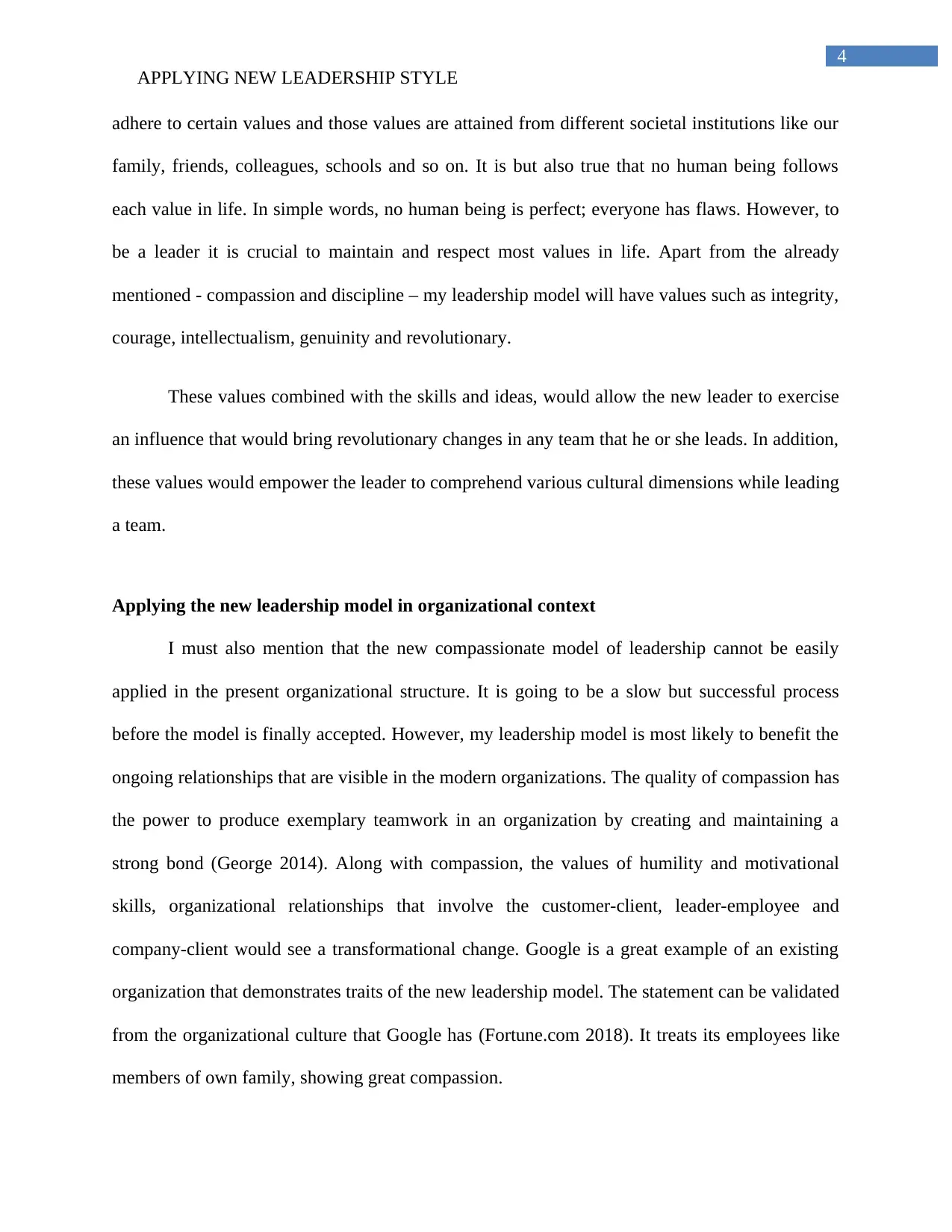
4
APPLYING NEW LEADERSHIP STYLE
adhere to certain values and those values are attained from different societal institutions like our
family, friends, colleagues, schools and so on. It is but also true that no human being follows
each value in life. In simple words, no human being is perfect; everyone has flaws. However, to
be a leader it is crucial to maintain and respect most values in life. Apart from the already
mentioned - compassion and discipline – my leadership model will have values such as integrity,
courage, intellectualism, genuinity and revolutionary.
These values combined with the skills and ideas, would allow the new leader to exercise
an influence that would bring revolutionary changes in any team that he or she leads. In addition,
these values would empower the leader to comprehend various cultural dimensions while leading
a team.
Applying the new leadership model in organizational context
I must also mention that the new compassionate model of leadership cannot be easily
applied in the present organizational structure. It is going to be a slow but successful process
before the model is finally accepted. However, my leadership model is most likely to benefit the
ongoing relationships that are visible in the modern organizations. The quality of compassion has
the power to produce exemplary teamwork in an organization by creating and maintaining a
strong bond (George 2014). Along with compassion, the values of humility and motivational
skills, organizational relationships that involve the customer-client, leader-employee and
company-client would see a transformational change. Google is a great example of an existing
organization that demonstrates traits of the new leadership model. The statement can be validated
from the organizational culture that Google has (Fortune.com 2018). It treats its employees like
members of own family, showing great compassion.
APPLYING NEW LEADERSHIP STYLE
adhere to certain values and those values are attained from different societal institutions like our
family, friends, colleagues, schools and so on. It is but also true that no human being follows
each value in life. In simple words, no human being is perfect; everyone has flaws. However, to
be a leader it is crucial to maintain and respect most values in life. Apart from the already
mentioned - compassion and discipline – my leadership model will have values such as integrity,
courage, intellectualism, genuinity and revolutionary.
These values combined with the skills and ideas, would allow the new leader to exercise
an influence that would bring revolutionary changes in any team that he or she leads. In addition,
these values would empower the leader to comprehend various cultural dimensions while leading
a team.
Applying the new leadership model in organizational context
I must also mention that the new compassionate model of leadership cannot be easily
applied in the present organizational structure. It is going to be a slow but successful process
before the model is finally accepted. However, my leadership model is most likely to benefit the
ongoing relationships that are visible in the modern organizations. The quality of compassion has
the power to produce exemplary teamwork in an organization by creating and maintaining a
strong bond (George 2014). Along with compassion, the values of humility and motivational
skills, organizational relationships that involve the customer-client, leader-employee and
company-client would see a transformational change. Google is a great example of an existing
organization that demonstrates traits of the new leadership model. The statement can be validated
from the organizational culture that Google has (Fortune.com 2018). It treats its employees like
members of own family, showing great compassion.
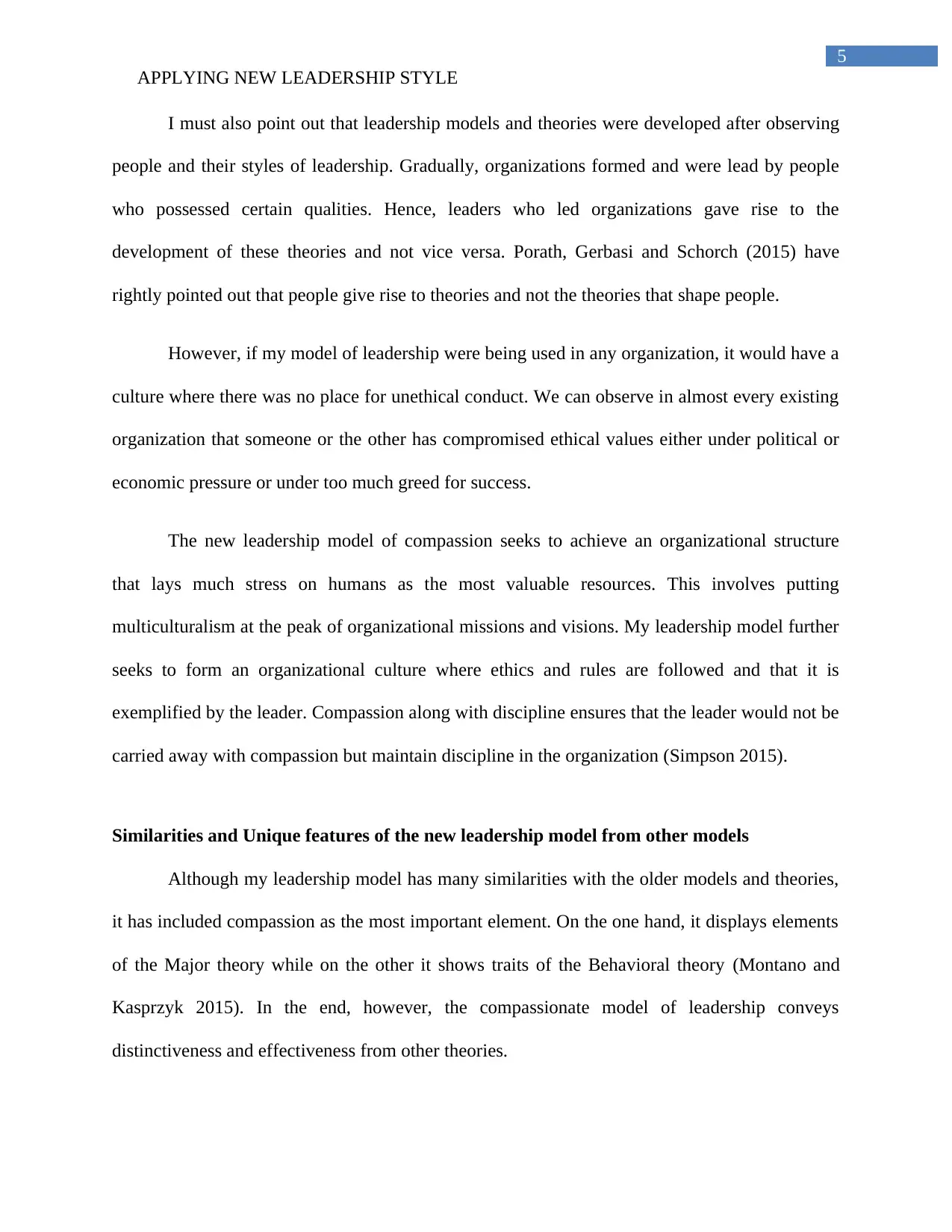
5
APPLYING NEW LEADERSHIP STYLE
I must also point out that leadership models and theories were developed after observing
people and their styles of leadership. Gradually, organizations formed and were lead by people
who possessed certain qualities. Hence, leaders who led organizations gave rise to the
development of these theories and not vice versa. Porath, Gerbasi and Schorch (2015) have
rightly pointed out that people give rise to theories and not the theories that shape people.
However, if my model of leadership were being used in any organization, it would have a
culture where there was no place for unethical conduct. We can observe in almost every existing
organization that someone or the other has compromised ethical values either under political or
economic pressure or under too much greed for success.
The new leadership model of compassion seeks to achieve an organizational structure
that lays much stress on humans as the most valuable resources. This involves putting
multiculturalism at the peak of organizational missions and visions. My leadership model further
seeks to form an organizational culture where ethics and rules are followed and that it is
exemplified by the leader. Compassion along with discipline ensures that the leader would not be
carried away with compassion but maintain discipline in the organization (Simpson 2015).
Similarities and Unique features of the new leadership model from other models
Although my leadership model has many similarities with the older models and theories,
it has included compassion as the most important element. On the one hand, it displays elements
of the Major theory while on the other it shows traits of the Behavioral theory (Montano and
Kasprzyk 2015). In the end, however, the compassionate model of leadership conveys
distinctiveness and effectiveness from other theories.
APPLYING NEW LEADERSHIP STYLE
I must also point out that leadership models and theories were developed after observing
people and their styles of leadership. Gradually, organizations formed and were lead by people
who possessed certain qualities. Hence, leaders who led organizations gave rise to the
development of these theories and not vice versa. Porath, Gerbasi and Schorch (2015) have
rightly pointed out that people give rise to theories and not the theories that shape people.
However, if my model of leadership were being used in any organization, it would have a
culture where there was no place for unethical conduct. We can observe in almost every existing
organization that someone or the other has compromised ethical values either under political or
economic pressure or under too much greed for success.
The new leadership model of compassion seeks to achieve an organizational structure
that lays much stress on humans as the most valuable resources. This involves putting
multiculturalism at the peak of organizational missions and visions. My leadership model further
seeks to form an organizational culture where ethics and rules are followed and that it is
exemplified by the leader. Compassion along with discipline ensures that the leader would not be
carried away with compassion but maintain discipline in the organization (Simpson 2015).
Similarities and Unique features of the new leadership model from other models
Although my leadership model has many similarities with the older models and theories,
it has included compassion as the most important element. On the one hand, it displays elements
of the Major theory while on the other it shows traits of the Behavioral theory (Montano and
Kasprzyk 2015). In the end, however, the compassionate model of leadership conveys
distinctiveness and effectiveness from other theories.
⊘ This is a preview!⊘
Do you want full access?
Subscribe today to unlock all pages.

Trusted by 1+ million students worldwide
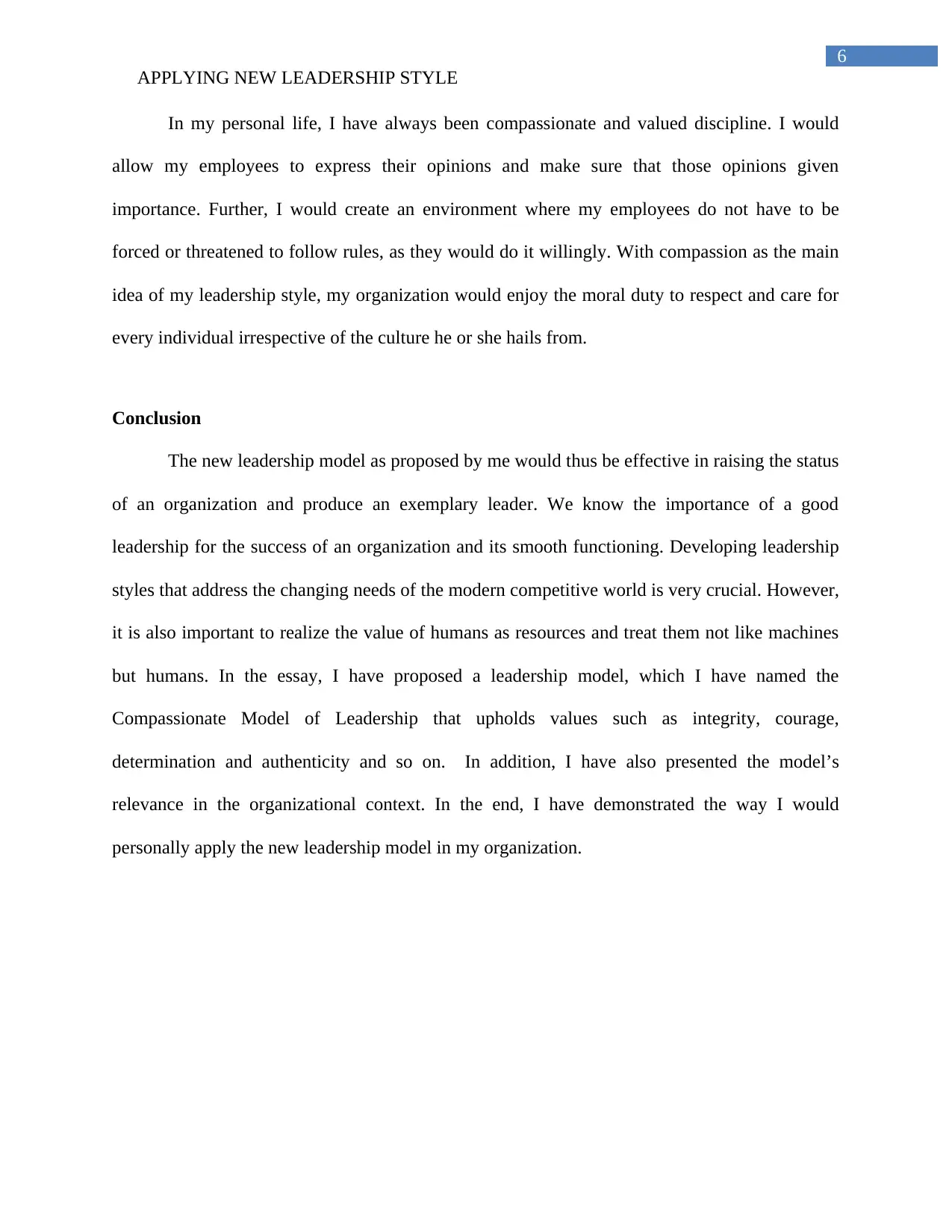
6
APPLYING NEW LEADERSHIP STYLE
In my personal life, I have always been compassionate and valued discipline. I would
allow my employees to express their opinions and make sure that those opinions given
importance. Further, I would create an environment where my employees do not have to be
forced or threatened to follow rules, as they would do it willingly. With compassion as the main
idea of my leadership style, my organization would enjoy the moral duty to respect and care for
every individual irrespective of the culture he or she hails from.
Conclusion
The new leadership model as proposed by me would thus be effective in raising the status
of an organization and produce an exemplary leader. We know the importance of a good
leadership for the success of an organization and its smooth functioning. Developing leadership
styles that address the changing needs of the modern competitive world is very crucial. However,
it is also important to realize the value of humans as resources and treat them not like machines
but humans. In the essay, I have proposed a leadership model, which I have named the
Compassionate Model of Leadership that upholds values such as integrity, courage,
determination and authenticity and so on. In addition, I have also presented the model’s
relevance in the organizational context. In the end, I have demonstrated the way I would
personally apply the new leadership model in my organization.
APPLYING NEW LEADERSHIP STYLE
In my personal life, I have always been compassionate and valued discipline. I would
allow my employees to express their opinions and make sure that those opinions given
importance. Further, I would create an environment where my employees do not have to be
forced or threatened to follow rules, as they would do it willingly. With compassion as the main
idea of my leadership style, my organization would enjoy the moral duty to respect and care for
every individual irrespective of the culture he or she hails from.
Conclusion
The new leadership model as proposed by me would thus be effective in raising the status
of an organization and produce an exemplary leader. We know the importance of a good
leadership for the success of an organization and its smooth functioning. Developing leadership
styles that address the changing needs of the modern competitive world is very crucial. However,
it is also important to realize the value of humans as resources and treat them not like machines
but humans. In the essay, I have proposed a leadership model, which I have named the
Compassionate Model of Leadership that upholds values such as integrity, courage,
determination and authenticity and so on. In addition, I have also presented the model’s
relevance in the organizational context. In the end, I have demonstrated the way I would
personally apply the new leadership model in my organization.
Paraphrase This Document
Need a fresh take? Get an instant paraphrase of this document with our AI Paraphraser
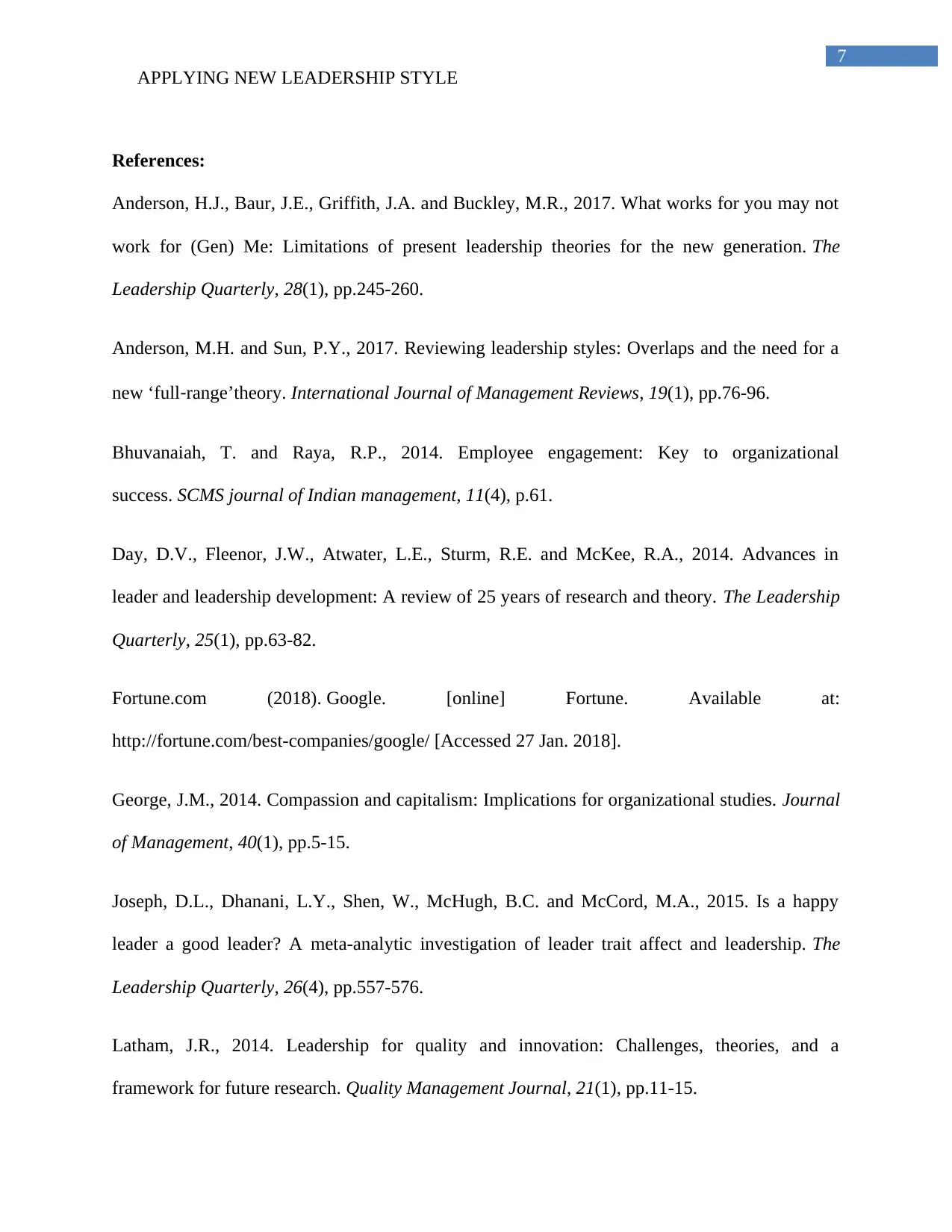
7
APPLYING NEW LEADERSHIP STYLE
References:
Anderson, H.J., Baur, J.E., Griffith, J.A. and Buckley, M.R., 2017. What works for you may not
work for (Gen) Me: Limitations of present leadership theories for the new generation. The
Leadership Quarterly, 28(1), pp.245-260.
Anderson, M.H. and Sun, P.Y., 2017. Reviewing leadership styles: Overlaps and the need for a
new ‘full‐range’theory. International Journal of Management Reviews, 19(1), pp.76-96.
Bhuvanaiah, T. and Raya, R.P., 2014. Employee engagement: Key to organizational
success. SCMS journal of Indian management, 11(4), p.61.
Day, D.V., Fleenor, J.W., Atwater, L.E., Sturm, R.E. and McKee, R.A., 2014. Advances in
leader and leadership development: A review of 25 years of research and theory. The Leadership
Quarterly, 25(1), pp.63-82.
Fortune.com (2018). Google. [online] Fortune. Available at:
http://fortune.com/best-companies/google/ [Accessed 27 Jan. 2018].
George, J.M., 2014. Compassion and capitalism: Implications for organizational studies. Journal
of Management, 40(1), pp.5-15.
Joseph, D.L., Dhanani, L.Y., Shen, W., McHugh, B.C. and McCord, M.A., 2015. Is a happy
leader a good leader? A meta-analytic investigation of leader trait affect and leadership. The
Leadership Quarterly, 26(4), pp.557-576.
Latham, J.R., 2014. Leadership for quality and innovation: Challenges, theories, and a
framework for future research. Quality Management Journal, 21(1), pp.11-15.
APPLYING NEW LEADERSHIP STYLE
References:
Anderson, H.J., Baur, J.E., Griffith, J.A. and Buckley, M.R., 2017. What works for you may not
work for (Gen) Me: Limitations of present leadership theories for the new generation. The
Leadership Quarterly, 28(1), pp.245-260.
Anderson, M.H. and Sun, P.Y., 2017. Reviewing leadership styles: Overlaps and the need for a
new ‘full‐range’theory. International Journal of Management Reviews, 19(1), pp.76-96.
Bhuvanaiah, T. and Raya, R.P., 2014. Employee engagement: Key to organizational
success. SCMS journal of Indian management, 11(4), p.61.
Day, D.V., Fleenor, J.W., Atwater, L.E., Sturm, R.E. and McKee, R.A., 2014. Advances in
leader and leadership development: A review of 25 years of research and theory. The Leadership
Quarterly, 25(1), pp.63-82.
Fortune.com (2018). Google. [online] Fortune. Available at:
http://fortune.com/best-companies/google/ [Accessed 27 Jan. 2018].
George, J.M., 2014. Compassion and capitalism: Implications for organizational studies. Journal
of Management, 40(1), pp.5-15.
Joseph, D.L., Dhanani, L.Y., Shen, W., McHugh, B.C. and McCord, M.A., 2015. Is a happy
leader a good leader? A meta-analytic investigation of leader trait affect and leadership. The
Leadership Quarterly, 26(4), pp.557-576.
Latham, J.R., 2014. Leadership for quality and innovation: Challenges, theories, and a
framework for future research. Quality Management Journal, 21(1), pp.11-15.
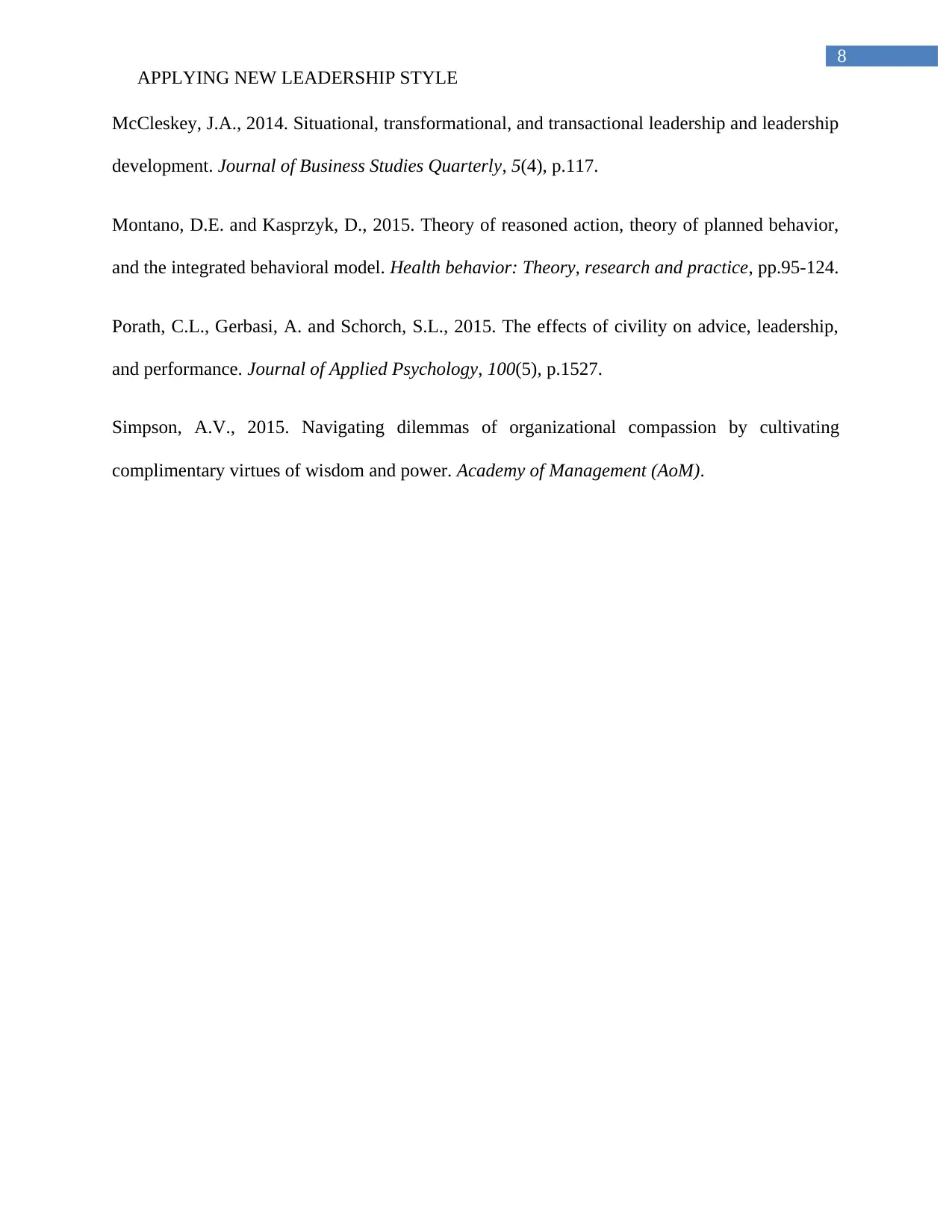
8
APPLYING NEW LEADERSHIP STYLE
McCleskey, J.A., 2014. Situational, transformational, and transactional leadership and leadership
development. Journal of Business Studies Quarterly, 5(4), p.117.
Montano, D.E. and Kasprzyk, D., 2015. Theory of reasoned action, theory of planned behavior,
and the integrated behavioral model. Health behavior: Theory, research and practice, pp.95-124.
Porath, C.L., Gerbasi, A. and Schorch, S.L., 2015. The effects of civility on advice, leadership,
and performance. Journal of Applied Psychology, 100(5), p.1527.
Simpson, A.V., 2015. Navigating dilemmas of organizational compassion by cultivating
complimentary virtues of wisdom and power. Academy of Management (AoM).
APPLYING NEW LEADERSHIP STYLE
McCleskey, J.A., 2014. Situational, transformational, and transactional leadership and leadership
development. Journal of Business Studies Quarterly, 5(4), p.117.
Montano, D.E. and Kasprzyk, D., 2015. Theory of reasoned action, theory of planned behavior,
and the integrated behavioral model. Health behavior: Theory, research and practice, pp.95-124.
Porath, C.L., Gerbasi, A. and Schorch, S.L., 2015. The effects of civility on advice, leadership,
and performance. Journal of Applied Psychology, 100(5), p.1527.
Simpson, A.V., 2015. Navigating dilemmas of organizational compassion by cultivating
complimentary virtues of wisdom and power. Academy of Management (AoM).
⊘ This is a preview!⊘
Do you want full access?
Subscribe today to unlock all pages.

Trusted by 1+ million students worldwide
1 out of 9
Related Documents
Your All-in-One AI-Powered Toolkit for Academic Success.
+13062052269
info@desklib.com
Available 24*7 on WhatsApp / Email
![[object Object]](/_next/static/media/star-bottom.7253800d.svg)
Unlock your academic potential
Copyright © 2020–2025 A2Z Services. All Rights Reserved. Developed and managed by ZUCOL.




